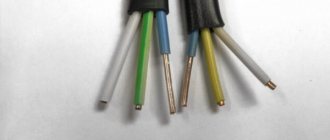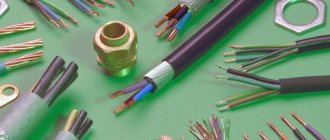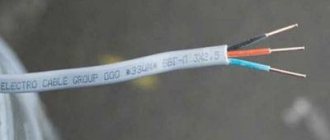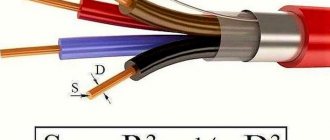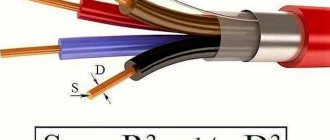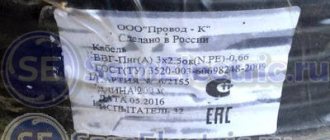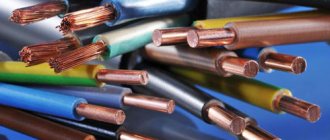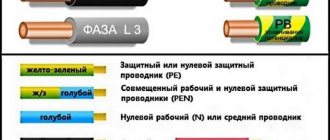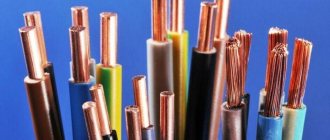When installing electrical wiring, it is necessary to ensure that the actual cross-section of the conductor corresponds to that specified in the project, since this parameter determines the resistance to electric current, and if there is a discrepancy, overheating and a risk of fire will occur. In practice, there are situations when the purchased wire is not marked at all or the electrician has doubts about the compliance of the declared characteristics with the actual ones. In this case, you need to know how to determine the cross-section of the wire at the work site.
General information about cable and wire
When working with conductors, it is necessary to understand their designation.
There are wires and cables that differ from each other in their internal structure and technical characteristics. However, many people often confuse these concepts. A wire is a conductor that has in its design one wire or a group of wires woven together and a thin common insulating layer. A cable is a core or a group of cores that has both its own insulation and a common insulating layer (sheath). Each type of conductor will have its own methods for determining cross sections, which are almost similar.
How and with what to measure the diameter of a wire (wire)
To measure the diameter of the wire, a caliper or micrometer of any type (mechanical or electronic) is suitable. It’s easier to work with electronic ones, but not everyone has them. You need to measure the core itself without insulation, so first move it aside or remove a small piece. This can be done if the seller allows it. If not, buy a small piece to test and take measurements on it.
On a conductor stripped of insulation, measure the diameter, after which you can determine the actual cross-section of the wire from the found dimensions. Which measuring device is better in this case? If we talk about mechanical models, then a micrometer. Its measurement accuracy is higher. If we talk about electronic options, then for our purposes they both give quite reliable results.
If you don't have a caliper or micrometer, take a screwdriver and a ruler with you. You'll have to strip a fairly decent piece of conductor, so you'll hardly be able to do without buying a test sample this time. So, remove the insulation from a 5-10 cm piece of wire.
Wind the wire around the cylindrical part of the screwdriver. Lay the coils close to each other, without a gap. All turns must be complete, that is, the “tails” of the wire must stick out in one direction - up or down, for example.
The number of turns is not important - about 10. You can have more or less, it’s just easier to divide by 10. Count the turns, then apply the resulting winding to the ruler, aligning the beginning of the first turn with the zero mark (as in the photo). Measure the length of the section occupied by the wire, then divide it by the number of turns. You get the diameter of the wire. It's that simple.
For example, let's calculate the size of the wire shown in the photo above. The number of turns in this case is 11, they occupy 7.5 mm. Divide 7.5 by 11, we get 0.68 mm. This will be the diameter of this wire. Next, you can look for the cross section of this conductor.
Conductor materials
The amount of energy that a conductor transmits depends on a number of factors, the main one of which is the material of the current-carrying conductors. The following non-ferrous metals can be used as the core material of wires and cables:
- Aluminum. Cheap and lightweight conductors, which is their advantage. They are characterized by such negative qualities as low electrical conductivity, a tendency to mechanical damage, high transient electrical resistance of oxidized surfaces;
- Copper. The most popular conductors, which have a high cost compared to other options. However, they are characterized by low electrical and transition resistance at the contacts, fairly high elasticity and strength, and ease of soldering and welding;
- Aluminum copper. Cable products with aluminum cores coated with copper. They are characterized by slightly lower electrical conductivity than their copper counterparts. They are also characterized by lightness, average resistance and relative cheapness.
Some methods for determining the cross-section of cables and wires will depend specifically on the material of their conductor component, which directly affects the throughput power and current strength (method of determining the cross-section of conductors by power and current).
Cable selection
It is best to make internal wiring using copper wires. Although aluminum ones are not inferior to them. But there is one nuance here, which is associated with the correct connection of sections in the distribution box. As practice shows, connections often fail due to oxidation of the aluminum wire.
Another question is which wire to choose: single-core or stranded? Single-core has better current conductivity, so it is recommended for use in household electrical wiring. Multicore has high flexibility, which allows it to be bent in one place several times without compromising quality.
Single or stranded
When installing electrical wiring, wires and cables of the PVS, VVGng, PPV, APPV brands are usually used. This list contains both flexible cables and monocore cables.
Here we would like to tell you one thing. If your wiring will not move, that is, it is not an extension cord, or a bend point that constantly changes its position, then it is preferable to use a monocore.
You will ask why? It's simple! No matter how well the conductors are laid in the protective insulating braid, air containing oxygen will still get under it. Oxidation of the copper surface occurs.
As a result, if there are many conductors, then the oxidation area is much larger, which means the current-carrying cross-section “melts” much more. Yes, this is a long process, but we don’t think that you are going to change the wiring often. The more she works, the better.
This oxidation effect will be especially pronounced at the edges of the cable cut, in rooms with temperature changes and high humidity. So we strongly recommend that you use monocore! The cross-section of a monocore cable or wire will change slightly over time, and this is so important for our further calculations.
Copper or aluminum
In the USSR, most residential buildings were equipped with aluminum wiring; this was a kind of norm, standard, and even dogma. No, this does not mean at all that the country was poor and there was a shortage of copper. Even in some cases it's the other way around.
But apparently the designers of electrical networks decided that they could save a lot economically if they used aluminum rather than copper. Indeed, the pace of construction was enormous; just remember the Khrushchev buildings, in which half of the country still lives, which means the effect of such savings was significant. There is no doubt about this.
However, today the realities are different, and aluminum wiring is not used in new residential premises, only copper. This is based on the rules of the PUE, clause 7.1.34 “Cables and wires with copper conductors should be used in buildings...”.
So, we strongly do not recommend that you experiment and try aluminum. Its disadvantages are obvious. Aluminum strands cannot be soldered and are also very difficult to weld; as a result, the contacts in the junction boxes may break over time. Aluminum is very fragile, two or three bends and the wire falls off.
There will be constant problems connecting it to sockets and switches. Again, if we talk about conducted power, then a copper wire with the same cross-section for aluminum is 2.5 mm2. allows a continuous current of 19A, and for copper 25A. Here the difference is more than 1 kW.
So let’s repeat it again - only copper! Further, we will proceed from the fact that we are calculating the cross-section for a copper wire, but in the tables we will also give values for aluminum. You never know.
Why is cable calculation necessary?
When choosing the cross-section of wires, you cannot follow the “by eye” principle. As current flows through the wires, it heats them up. The higher the current, the more heating occurs. This relationship is easy to prove with a couple of formulas. The first of them determines the active current strength:
where I is current, U is voltage, R is resistance.
The formula shows: the greater the resistance, the more heat will be generated, i.e., the more the conductor will heat up. Resistance is determined by the formula:
R = ρ · L/S (2), where ρ is the resistivity, L is the length of the conductor, S is its cross-sectional area. The smaller the cross-sectional area of the conductor, the higher its resistance, and therefore the higher the active power, which indicates stronger heating. Based on this, calculation of the cross-section is necessary to ensure the safety and reliability of the wiring, as well as the competent distribution of finances.
What are electrical cables made of?
The main conductor of electric current is aluminum or copper conductors. The larger their diameter, the higher the cable's capabilities.
Aluminum wires are cheaper, but they are more likely to deteriorate and have a lower electrical conductivity coefficient.
Copper cable is durable, does not break at bends and is capable of carrying more current than aluminum cable with the same diameter.
It is recommended that all wiring in the house be of the same type. This is due to the fact that to connect products from different materials, a special adapter will be required so as not to create a galvanic couple. In this case, oxidation and destruction of the wires occurs, which can lead to a short circuit.
The main cores are covered in braids made of rubber, polyethylene or PVC. Often several of these insulated conductors are combined into a bundle, which in turn is covered with a protective sheath.
Calculator for calculating cross-section by diameter
To simplify calculations, a calculator has been developed for calculating cable cross-section by diameter. It is based on formulas that can be used to find the cross-sectional area of single-core and stranded wires.
You need to measure the cross-section by measuring the core without insulation, otherwise nothing will work. When it comes to calculating tens and hundreds of values, an online calculator can significantly simplify the life of electricians and electrical network designers due to convenience and increased speed of calculations. It is enough to enter the value of the core diameter, and, if necessary, indicate the number of wires if the cable is multi-core, and the service will show the required wire cross-section.
What is the deception?
If you don’t know and understand what a 4-square wire looks like or what its diameter is, you can easily be deceived. This deception can come from both the contractor’s electrician and negligent manufacturers. What exactly does it involve?
For example, you entrusted all obligations for selecting wiring for your apartment to a specialist. He must go to the supermarket and use the funds allocated by you to purchase a wire network that meets your requirements and conditions for using electricity. Since you understand absolutely nothing about the sizes, sections, and carrying capacities of wires, you completely rely on the responsible contractor.
In turn, he can conscientiously fulfill your instructions and purchase the cable you need, or he can take advantage of your trust for selfish purposes and buy a cheaper, and, accordingly, lower-grade product. He will simply take the difference and put it in his pocket. The wiring will, of course, be installed. But you will live in peace and not even suspect the threats of the poor quality of your wiring and the fact that you were simply deceived.
Another way to be deceived is to trust the cable industry manufacturers completely and completely. Even despite the fairly high competition, in the conditions of which all suppliers of cable products try to work to the maximum and in no case lose their customers, they often resort to various kinds of tricks. One of the most common such tricks is saving on metal by reducing the conductor diameter. Just think: the manufacturer only needs to reduce the cross-section of a 10-square-meter wire by just a couple of mm2 (what diameter will it correspond to?) in order to break even by significantly reducing the cost of selling hundreds of kilometers of this cable! He feels good, but you may be left with nothing. Or, it would be more correct to say, at the burnt-out wiring. After all, the resistance of the purchased conductor will be much lower than that stated in the markings and documentation.
That is why it is so important to have at least minimal information about what the wires should be like, what the difference is in diameter and cross-section in the cable, and on what basis calculations are made.
Three main ways to determine wire diameter
There are several methods, but each of them is based on determining the diameters of the core with subsequent calculations of the final results.
Method one. Using instruments. Today there are a number of instruments that help measure the diameter of a wire or wire strand. This is a micrometer and caliper, which come in both mechanical and electronic (see below).
This option is primarily suitable for professional electricians who are constantly installing electrical wiring. The most accurate results can be obtained using a caliper. This technique has the advantage that it is possible to measure the wire diameter even on a section of a working line, for example, in a socket.
After you have measured the diameter of the wire, you need to make calculations using the following formula:
It must be remembered that the number “Pi” is 3.14, so if we divide the number “Pi” by 4, we can simplify the formula and reduce the calculation to multiplying 0.785 by the diameter squared.
Method two. We use a ruler. If you decide not to spend money on a device, which is logical in this situation, then you can use a simple proven method for measuring the cross-section of a wire or wire?. You will need a simple pencil, ruler and wire. Strip the core of insulation, wind it tightly onto a pencil, and then use a ruler to measure the total length of the winding (as shown in the figure).
Then divide the length of the wound wire by the number of cores. The resulting value will be the diameter of the wire cross-section.
But the following must be taken into account:
- the more cores you wind on a pencil, the more accurate the result will be; the number of turns should be at least 15;
- press the coils tightly against each other so that there is no free space between them, this will significantly reduce the error;
- take measurements several times (change the measuring side, the direction of the ruler, etc.). Several results obtained will again help you avoid a large error.
Please note the disadvantages of this measurement method:
- You can only measure the cross-section of thin wires, since it will be difficult for you to wind a thick wire around a pencil.
- To begin with, you will need to purchase a small piece of the product before making the main purchase.
The formula discussed above is suitable for all measurements.
Method three. We use the table. In order not to carry out calculations using the formula, you can use a special table that indicates the diameter of the wire? (in millimeters) and conductor cross-section (in square millimeters). Ready-made tables will give you more accurate results and will significantly save your time, which you will not have to spend on calculations.
| Conductor diameter, mm | Conductor cross-section, mm² |
| 0.8 | 0.5 |
| 1 | 0.75 |
| 1.1 | 1 |
| 1.2 | 1.2 |
| 1.4 | 1.5 |
| 1.6 | 2 |
| 1.8 | 2.5 |
| 2 | 3 |
| 2.3 | 4 |
| 2.5 | 5 |
| 2.8 | 6 |
| 3.2 | 8 |
| 3.6 | 10 |
| 4.5 | 16 |
Wire diameter and diameter correspondence table with definition of cross-section
This table will save you from the need to make unnecessary calculations. Despite the fact that each cable coil has a tag that indicates its marking and all its parameters, you should not trust what is written. It would be better to play it safe and measure the diameter of the conductor, and then use the table to estimate approximately what its cross-section is.
| Diameter of conductor element, mm | Cross-sectional area of the conductor element, mm2 |
| 0,8 | 0,5 |
| 0,9 | 0,63 |
| 1 | 0,75 |
| 1,1 | 0,95 |
| 1,2 | 1,13 |
| 1,3 | 1,33 |
| 1,4 | 1,53 |
| 1,5 | 1,77 |
| 1,6 | 2 |
| 1,8 | 2,54 |
Diameter correspondence table with definition of cross-section
Cable products with a cross-section of up to 10 mm2 are almost always produced in a round shape. To meet the domestic needs of houses and apartments, such conductors are quite sufficient. However, with a larger cross-section of the cable, the input cores from the external electrical network can be made in segment (sector) form, and it will be quite difficult to determine the cross-section of the wire by diameter.
It is best to use a micrometer or caliper to measure the thickness (diameter) of the wire. Micrometers are a priority, it doesn’t matter - mechanical or electronic, they will show the most accurate result. However, the results given by a caliper will also work quite well. To make a measurement, you need to clean the wire from the plastic insulation, but not every seller will allow such actions with the end of the wire on a coil put up for sale. Therefore, it is best to buy a meter of cable in advance and then take measurements. Once data on the diameter of the core has been obtained, you can begin to calculate the cross-section.
Marking of wires by diameter
In particular, the following will be written on the tag: “VVNG 2x4.” This encoding means the following: in the cable - the number of cores is 2, each of which has a cross-section of 4 mm2. To confirm or refute the stated parameters, we measure the diameter of the cable core without insulation using one of the methods. We carry out calculations.
Wire marking
The procedure for calculating the power cross section
In general, the calculation of the cable cross-section for power occurs in 2 stages. To do this you will need the following data:
- Total power of all devices.
- Network voltage type: 220 V – single-phase, 380 V – three-phase.
- PUE 7. Rules for electrical installations. Edition 7.
- Conductor material: copper or aluminum.
- Wiring type: open or closed.
Step 1. The power consumption of electrical appliances can be found in their instructions or take the average characteristics. Formula for calculating total power:
ΣP = (P₁ + Р₂ + … + Рₙ) · Кс · Кз,
where P1, P2, etc. is the power of connected devices, Kc is the demand factor, which takes into account the probability of turning on all devices at the same time, Kz is the safety factor in case of adding new devices in the house. KS is defined as follows:
- for two simultaneously switched on devices – 1;
- for 3-4 – 0.8;
- for 5-6 – 0.75;
- for larger quantities – 0.7.
In calculating the cable load, it makes sense to take the short circuit as 1.15-1.2. For example, you can take a total power of 5 kW.
Step 2. At the second stage, it remains to determine the cross-section of the conductor based on the total power. For this purpose, a table for calculating the cable cross-section from the PUE is used. It provides information for both copper and aluminum conductors. With a power of 5 kW and a closed single-phase electrical network, a copper cable with a cross-section of 4 mm2 is suitable.
Segment cable cross-section
What is the difference between a cable and a wire?
Cable products with a cross-section of up to 10 mm2 are almost always produced in a round shape. Such conductors are quite sufficient to meet the domestic needs of houses and apartments. However, with a larger cross-section of the cable, the input cores from the external electrical network can be made in segment (sector) form, and it will be quite difficult to determine the cross-section of the wire by diameter.
Aluminum cable with sector conductors
In such cases, it is necessary to resort to a table where the size (height, width) of the cable takes the corresponding value of the cross-sectional area. Initially, it is necessary to measure the height and width of the required segment with a ruler, after which the required parameter can be calculated by correlating the obtained data.
Table for calculating the area of an electric cable core sector
| Cable type | Sectional area of the segment, mm2 | ||||||||
| S | 35 | 50 | 70 | 95 | 120 | 150 | 185 | 240 | |
| Four-core segment | V | — | 7 | 8,2 | 9,6 | 10,8 | 12 | 13,2 | — |
| w | — | 10 | 12 | 14,1 | 16 | 18 | 18 | — | |
| Three-core segmental stranded, 6(10) | V | 6 | 7 | 9 | 10 | 11 | 12 | 13,2 | 15,2 |
| w | 10 | 12 | 14 | 16 | 18 | 20 | 22 | 25 | |
| Three-core segmental single-wire, 6(10) | V | 5,5 | 6,4 | 7,6 | 9 | 10,1 | 11,3 | 12,5 | 14,4 |
| w | 9,2 | 10,5 | 12,5 | 15 | 16,6 | 18,4 | 20,7 | 23,8 | |
Length calculation rules
Calculation of the cable cross-section along the length assumes that the owner has determined in advance how many meters of conductor will be required for the electrical wiring. This method is usually used at home. For the calculation you will need the following data:
- L – conductor length, m. For example, the value taken is 40 m.
- ρ – resistivity of the material (copper or aluminum), Ohm/mm2 m: 0.0175 for copper and 0.0281 for aluminum.
- I – rated current, A.
Step 1. Determine the rated current using the formula:
I = (P Ks) / (U cos ϕ) = 8000/220 = 36 A,
where P is the power in watts (the total of all appliances in the house, for example, the value is 8 kW), U is 220 V, Ks is the simultaneous switching factor (0.75), cos φ is 1 for household appliances. In the example, the value turned out to be 36 A.
Step 2. Determine the cross-section of the conductor. To do this you need to use formula (2):
R = ρ · L/S.
The voltage loss along the length of the conductor should be no more than 5%:
dU = 0.05 220 V = 11 V.
Voltage loss dU = I R, hence R = dU/I = 11/36 = 0.31 Ohm. Then the cross-section of the conductor must be no less than:
S = ρ · L/R = 0.0175 · 40/0.31 = 2.25 mm2.
In the case of a three-core cable, the cross-sectional area of one core should be 0.75 mm2. Hence, the diameter of one core must be at least (√S/ π) · 2 = 0.98 mm. Cable BBGng 3×1.5 satisfies this condition.
Dependence of current, power and core cross-section
It is not enough to measure and calculate the cross-sectional area of the cable based on the diameter of the core. Before installing wiring or other types of electrical networks, it is also necessary to know the capacity of the cable products.
Wires for electrical wiring
When choosing a cable, you must be guided by several criteria:
- the strength of the electric current that the cable will pass;
- power consumed by energy sources;
- current load exerted on the cable.
Power
The most important parameter during electrical installation work (in particular, cable laying) is throughput. The maximum power of electricity transmitted through it depends on the cross-section of the conductor. Therefore, it is extremely important to know the total power of the energy consumption sources that will be connected to the wire.
Typically, manufacturers of household appliances, appliances and other electrical products indicate on the label and in the documentation accompanying them the maximum and average power consumption. For example, a washing machine can consume electricity ranging from tens of W/h during rinsing mode to 2.7 kW/h when heating water. Accordingly, a wire with a cross-section that is sufficient to transmit electricity of maximum power must be connected to it. If two or more consumers are connected to the cable, then the total power is determined by adding the limit values of each of them.
The average power of all electrical appliances and lighting devices in an apartment rarely exceeds 7500 W for a single-phase network. Accordingly, the cable cross-sections in the electrical wiring must be selected to this value.
On a note. It is recommended to round the cross-section towards higher power due to a possible increase in power consumption in the future. Typically, the next largest cross-sectional area from the calculated value is taken.
So, for a total power of 7.5 kW, it is necessary to use a copper cable with a core cross-section of 4 mm2, which is capable of transmitting about 8.3 kW. The cross-section of the conductor with an aluminum core in this case must be at least 6 mm2, passing a current power of 7.9 kW.
Marking labels for electrical appliances and household appliances indicating their rated power
In individual residential buildings, a three-phase power supply system of 380 V is often used. However, most equipment is not designed for such electrical voltage. A voltage of 220 V is created by connecting them to the network through a neutral cable with an even distribution of the current load across all phases.
Electric current
Often the power of electrical equipment and equipment may not be known to the owner due to the absence of this characteristic in the documentation or completely lost documents and labels. There is only one way out in such a situation - to calculate using the formula yourself.
Power is determined by the formula:
P = U*I, where:
- P – power, measured in watts (W);
- I – electric current strength, measured in amperes (A);
- U is the applied electrical voltage, measured in volts (V).
When the strength of the electric current is unknown, it can be measured with control and measuring instruments: an ammeter, a multimeter, and a clamp meter.
Measuring current with clamp meters
After determining the power consumption and electric current, you can use the table below to find out the required cable cross-section.
Load
Calculation of the cross-section of cable products based on current load must be carried out to further protect them from overheating. When too much electric current passes through conductors for their cross-section, destruction and melting of the insulating layer can occur.
The maximum permissible long-term current load is the quantitative value of the electric current that can pass the cable for a long time without overheating. To determine this indicator, it is initially necessary to sum up the powers of all energy consumers. After this, calculate the load using the formulas:
- I = P∑*Ki/U (single-phase network),
- I = P∑*Kи/(√3*U) (three-phase network), where:
- P∑ – total power of energy consumers;
- Ki – coefficient equal to 0.75;
- U – electrical voltage in the network.
Table of correspondence between the cross-sectional area of copper conductors of conductor products and current and power *
| Section of cable and wire products | Electrical voltage 220 V | Electrical voltage 380 V | ||
| Current strength, A | power, kWt | Current strength, A | power, kWt | |
| 2,5 | 27 | 5,9 | 25 | 16,5 |
| 4 | 38 | 8,3 | 30 | 19,8 |
| 6 | 50 | 11 | 40 | 26,4 |
| 10 | 70 | 15,4 | 50 | 33 |
| 16 | 90 | 19,8 | 75 | 49,5 |
| 25 | 115 | 25,3 | 90 | 59,4 |
| 35 | 140 | 30,8 | 115 | 75,9 |
| 50 | 175 | 38,5 | 145 | 95,7 |
| 70 | 215 | 47,3 | 180 | 118,8 |
| 95 | 260 | 57,2 | 220 | 145,2 |
| 120 | 300 | 66 | 260 | 171,6 |
* Important! Conductors with aluminum conductors have different values.
Determining the cross-section of a cable product is a particularly important process in which miscalculations are unacceptable. You need to take into account all factors, parameters and rules, trusting only your calculations. The measurements taken must coincide with the tables described above - if they do not contain specific values, they can be found in the tables of many electrical engineering reference books.
Calculation for stranded wire
Stranded wire (stranded) consists of single-core wires twisted together. Anyone who is even a little familiar with mathematics understands perfectly well that it is necessary to count the number of these wires in a stranded wire. After this, the cross-section of one thin wire is measured and multiplied by their total number. Let's consider the following options.
Calculation using a caliper
The measurement is carried out with a caliper with a conventional scale (or micrometer). Experienced craftsmen always have this tool at hand, but not everyone is a professional electrician.
To do this, using the VVGng cable as an example, cut the thick sheath with a knife and spread the wires in different directions.
Then select one core and strip it with a knife or scissors. Next, measure this core. The size should be 1.8 mm. Please refer to the calculations to prove the measurement is correct.
The resulting figure of 2.54 mm² is the actual cross-section of the core.
Measuring with a pen or pencil
If you don’t have a caliper at hand, you can use improvised methods using a pencil and ruler. First, take the wire to be measured, strip it and wind it around a pencil or pen so that the turns lie close to each other. The more turns, the better. Now let's count the number of wound turns and measure their total length.
For example, we got 10 turns with a total winding length of 18 mm. It is easy to calculate the diameter of one turn; to do this, divide the total length by the number of turns.
As a result of all the calculations made using the formula, you will obtain the required diameter of the core. In this case it is 1.8 mm. Since the diameter of one core is known, it is not difficult to calculate the cross-section of the entire VVGng wire using the already known formula. You can see that the results were equal.
Using tables
How can you find out and measure the cable cross-section if you don’t have a caliper, a ruler, or a micrometer at hand? Instead of racking your brains over complex mathematical formulas, just remember that there are ready-made tables of values for measuring cable cross-section. There are, of course, very complex tables with many parameters, but, in principle, to begin with it is enough to use the simplest of the two columns. The diameter of the conductor is entered in the first column, and the ready-made values of the wire cross-section are given in the second column.
Wiring cross-section table for closed wiring
There is another “approximate” method that does not require measuring the thickness of individual wires. You can simply measure the cross-section (diameter) of the entire thick scroll. This method is usually used by experienced electricians. They can find out the cable cross-section both “by eye” and with the help of tools.
AVBbShv and AVBbShng
| Number of cores, nominal cross-section, mm2 | Core cross-sectional shape | Cable outer diameter, mm | Cable weight, kg/km |
| 1x50 | cool* RE* | 16,6 | 481 |
| 1x70 | 19,2 | 626 | |
| 1x95 | 22,2 | 821 | |
| 1x120 | 24,3 | 998 | |
| 1x150 | R.M. | 24,6 | 1030 |
| 1x185 | 26,6 | 1195 | |
| 1x240 | 31,7 | 1591 | |
| 1x300 | 33,9 | 1778 | |
| 1x400 | 37,5 | 2248 | |
| 1x500 | 40,6 | 2642 | |
| 1x625 | 44,3 | 3145 | |
| 1x800 | 53 | 4100 | |
| 2x4 | cool* RE* | 15,2 | 390 |
| 2x6 | 16,3 | 439 | |
| 2x10 | 17,8 | 526 | |
| 2x16 | 19,4 | 615 | |
| 2x25 | 22,6 | 669 | |
| 2x35 | 24,9 | 812 | |
| 2x50 | 27,9 | 989 | |
| 3x2.5 | cool RE | 14 | 329 |
| 3x4 | 16 | 420 | |
| 3x6 | 19,1 | 510 | |
| 3x10 | 20,9 | 594 | |
| 3x16 | 21,5 | 598 | |
| 3x25 | 25,2 | 807 | |
| 3x35 | cool* SE* | 24,2 | 881 |
| 3x50 | 27,4 | 1120 | |
| 3x70 | 30,1 | 1372 | |
| 3x95 | 33,5 | 1714 | |
| 3x120 | 36 | 2000 | |
| 3x150 | 39,2 | 2370 | |
| 3x185 | 42,6 | 2816 | |
| 3x240 | 47,9 | 3545 | |
| 3x4+1x2.5 | cool RE/RE | 15 | 362 |
| 3x6+1x4 | 20,4 | 563 | |
| 3x10+1x6 | 22,3 | 668 | |
| 3x16+1x10 | 22 | 655 | |
| 3x25+1x16 | 25,9 | 887 | |
| 3x35+1x16 | coolant* SE/RE | 26,7 | 1016 |
| 3x50+1x25 | 29,9 | 1276 | |
| 3x70+1x35 | 32,9 | 1564 | |
| 3x95+1x50 | 37,2 | 2000 | |
| 3x120+1x70 | 40,1 | 2358 | |
| 3x150+1x50 | 42,5 | 2624 | |
| 3x150+1x70 | 42,9 | 2696 | |
| 3x185+1x50 | 46,3 | 3114 | |
| 3x185+1x95 | 47,2 | 3282 | |
| 3x240+1x120 | SE/SE* | 52,3 | 4061 |
| 4x2.5 | cool RE | 15 | 362 |
| 4x4 | 17,1 | 472 | |
| 4x6 | 20,4 | 569 | |
| 4x10 | 22,3 | 681 | |
| 4x16 | 23,2 | 702 | |
| 4x25 | 27,3 | 959 | |
| 4x35 | cool* SE* | 27,1 | 1100 |
| 4x50 | 30,3 | 1372 | |
| 4x70 | 33,3 | 1694 | |
| 4x95 | 37,6 | 2172 | |
| 4x120 | 40,5 | 2542 | |
| 4x150 | 43,7 | 2979 | |
| 4x185 | 48 | 3600 | |
| 4x240 | 53,3 | 4487 |
Parallel connection of electrical wiring wires
There are hopeless situations when you urgently need to lay wiring, but there is no wire of the required cross-section available. In this case, if there is a wire with a smaller cross-section than necessary, then the wiring can be made from two or more wires, connecting them in parallel. The main thing is that the sum of the sections of each of them is not less than the calculated one.
For example, there are three wires with a cross-section of 2, 3 and 5 mm², but according to calculations, 10 mm² is needed. Connect them all in parallel and the wiring will handle up to 50 amps. Yes, you yourself have repeatedly seen the parallel connection of a large number of thin conductors to transmit large currents. For example, welding uses a current of up to 150 A and in order for the welder to control the electrode, a flexible wire is needed. It is made from hundreds of thin copper wires connected in parallel.
In a car, the battery is also connected to the on-board network using the same flexible stranded wire, since when starting the engine, the starter consumes current from the battery up to 100 A. And when installing and removing the battery, the wires must be taken to the side, that is, the wire must be flexible enough . The method of increasing the cross-section of an electrical wire by connecting several wires of different diameters in parallel can be used only as a last resort. When laying home electrical wiring, it is permissible to connect in parallel only wires of the same cross-section taken from the same reel.
Calculation of the cross-section of copper wires and cables
Having calculated the load and decided on the material (copper), let’s consider an example of calculating the cross-section of wires for individual groups of consumers, using the example of a two-room apartment.
As you know, the entire load is divided into two groups: power and lighting.
In our case, the main power load will be the socket group installed in the kitchen and bathroom. Since the most powerful equipment is installed there (electric kettle, microwave, refrigerator, boiler, washing machine, etc.).
For this socket group we select a wire with a cross section of 2.5mm2. Provided that the power load will be scattered across different outlets. What does it mean? For example, in the kitchen, to connect all household appliances, you need 3-4 sockets connected with copper wire with a cross-section of 2.5 mm2 each.
If all equipment is connected through one single socket, then a cross-section of 2.5 mm2 will not be enough, in this case you need to use a wire with a cross-section of 4-6 mm2. In living rooms, a wire with a cross section of 1.5 mm2 can be used to power sockets, but the final choice must be made after appropriate calculations.
The entire lighting load is powered by a wire with a cross section of 1.5 mm2.
It is necessary to understand that the power in different sections of the electrical wiring will be different, and accordingly the cross-section of the supply wires will also be different. Its greatest value will be in the introductory section of the apartment, since the entire load passes through it. The cross-section of the input supply wire is selected 4 - 6 mm2.
When installing electrical wiring, wires and cables of the PVS, VVGng, PPV, APPV brands are used.
Selection of cable cross-section by power
Now we get to the essence of our article. However, everything that was above cannot be missed, which means we could not remain silent.
If we try to present the idea logically and simply, then a current of a certain strength can pass through each conventional cross-section of a conductor. This conclusion is quite logical and now all that remains is to find out these ratios and correlate them for different wire diameters, based on its type series.
It also cannot be ignored that here, when calculating the current cross section, temperature also comes into play. Yes, this is a new component – temperature. It is she who can influence the cross section. How and why, let's figure it out.
We all know about Brownian motion. On the constant displacement of ions in a crystal lattice. All this happens in all materials, including conductors. The higher the temperature, the greater these vibrations of ions within the material will be. And we know that current is the directed movement of particles.
So, the directed movement of particles will collide with ions in the crystal lattice, which will lead to an increase in resistance to current.
The higher the temperature, the higher the electrical resistance of the conductor. Therefore, by default, the wire cross-section for a certain current is taken at room temperature, that is, at 18 degrees Celsius. It is at this temperature that all reference values are given in the tables, including ours.
Despite the fact that we do not consider aluminum wires as wires for electrical wiring, at least in an apartment, they are nevertheless used in many places. Let's say for wiring on the street. That is why we will also present the values of the cross-section and current dependencies for aluminum wires.
So, for copper and aluminum there will be the following indicators of the dependence of the cross-section of the wire (cable) on the current (power). See table.
Table of conductors for maximum permissible current for their use in wiring:
Since 2001, aluminum wires have not been used for wiring in apartments. (PEU)
Yes, here, as our reader noted, we actually did not provide calculations, but only provided reference data, tabulated, based on these calculations. But we dare to tell you that for calculations it is necessary to go through many formulas and indicators. Starting from temperature, resistivity, current density and the like.
Therefore, we will leave such calculations for specialists. It should be noted that they are not final, since they may vary slightly depending on the standard for the material and the current reserve of the wire used in different countries.
But what we would also like to talk about is converting the wire cross-section to diameter. This is necessary when there is a wire, but for some reason there is no marking on it. In this case, the cross-section can be calculated from the diameter of the wire, and vice versa from the diameter of the cross-section.
About choosing a cable brand for home wiring
Making apartment electrical wiring from aluminum wires at first glance seems cheaper, but operating costs due to low reliability of contacts over time will be many times higher than the costs of electrical wiring made from copper. I recommend making the wiring exclusively from copper wires! Aluminum wires are indispensable when laying overhead electrical wiring, as they are light and cheap and, when properly connected, serve reliably for a long time.
Which wire is better to use when installing electrical wiring, single-core or stranded? From the point of view of the ability to conduct current per unit of cross-section and installation, single-core is better. So for home wiring you only need to use solid wire. Stranded allows multiple bends, and the thinner the conductors in it, the more flexible and durable it is. Therefore, stranded wire is used to connect non-stationary electrical appliances to the electrical network, such as an electric hair dryer, an electric razor, an electric iron and all the others.
After deciding on the cross-section of the wire, the question arises about the brand of cable for electrical wiring. The choice here is not great and is represented by only a few brands of cables: PUNP, VVGng and NYM. PUNP cable since 1990, in accordance with the decision of Glavgosenergonadzor “On the ban on the use of wires such as APVN, PPBN, PEN, PUNP, etc., produced according to TU 16-505. 610-74 instead of APV, APPV, PV and PPV wires according to GOST 6323-79*" is prohibited for use.
Cable VVG and VVGng - copper wires in double polyvinyl chloride insulation, flat shape. Designed for operation at ambient temperatures from −50°С to +50°С, for wiring inside buildings, outdoors, in the ground when laid in tubes. Service life up to 30 years. The letters “ng” in the brand designation indicate the non-flammability of the wire insulation. Two-, three- and four-core wires are available with core cross-sections from 1.5 to 35.0 mm2. If in the cable designation there is a letter A (AVVG) before VVG, then the conductors in the wire are aluminum.
The NYM cable (its Russian analogue is the VVG cable), with copper cores, round in shape, with non-flammable insulation, complies with the German standard VDE 0250. Technical characteristics and scope of application are almost the same as the VVG cable. Two-, three- and four-core wires are available with core cross-sections from 1.5 to 4.0 mm².
As you can see, the choice for laying electrical wiring is not large and is determined depending on what shape the cable is more suitable for installation, round or flat. A round-shaped cable is more convenient to lay through walls, especially if the connection is made from the street into the room. You will need to drill a hole slightly larger than the diameter of the cable, and with a larger wall thickness this becomes relevant. For internal wiring, it is more convenient to use a VVG flat cable.
When laying apartment electrical wiring, as a rule, the question arises about choosing a circuit breaker, or, as it is often called, a machine. This issue and the choice of a meter, RCD, and differential circuit breaker are covered in detail in the website article “About the electric meter, RCD and circuit breakers.”
Cables for underground input
To supply electricity to a detached house, a cable is often laid by digging a trench in the ground. The following must be taken into account:
- The cross-section of the conductors must provide a general house load for both devices plugged into sockets and for lighting. The thickness of the cores in this case is at least 6 mm².
- For underground input, you need a shielded cable, which is designed for installation in a trench. Otherwise, use a metal pipe (corrugation) of the PND type.
- When calculating the depth of the trench, soil freezing must be taken into account.
- Sometimes rodents damage wiring.
Undersized wire cross-section - what is the danger?
So, let's consider the dangers that await us when using low-quality wires in everyday life. It is clear that the current characteristics of current-carrying conductors decrease in direct proportion to the decrease in their cross-section. The load capacity of the wire decreases due to the reduced cross-section. According to the standards, the current that the wire can pass through is calculated. It will not collapse if less current passes through it.
The resistance between the cores decreases if the insulation layer is thinner than required. Then, in an emergency situation, when the supply voltage increases, a breakdown may occur in the insulation. If, along with this, the core itself has a reduced cross-section, that is, it cannot pass the current that, according to standards, it should pass, the thin insulation begins to gradually melt.
All these factors will inevitably lead to a short circuit and then to a fire. A fire occurs from sparks that appear during a short circuit. Let me give you an example: a three-core copper wire (for example, with a cross-section of 2.5 2), according to regulatory documentation, can pass 27 A for a long time, usually 25 A is considered.
But the wires that come into my hands, produced in accordance with the specifications, actually have a cross-section from 1.8 mm2 to 2 mm2 (this is with the declared 2.5 mm2). Based on the regulatory documentation, a wire with a cross-section of 2 mm2 can carry a current of 19 A for a long time.
Therefore, if a situation occurs when a current designed for such a cross-section flows through the wire you have chosen, which supposedly has a cross-section of 2.5 mm2, the wire will overheat. And with prolonged exposure, the insulation will melt, followed by a short circuit.
Contact connections (for example, in a socket) will collapse very quickly if such overloads occur regularly. Therefore, the socket itself, as well as the plugs of household appliances, may also be subject to melting.
Now imagine the consequences of all this! It’s especially disappointing when a beautiful renovation has been made, new appliances have been installed, for example, an air conditioner, an electric oven, a hob, a washing machine, an electric kettle, a microwave oven. And so you put the buns in the oven to bake, started the washing machine, turned on the kettle, and even the air conditioner, since it became hot.
These switched on devices are enough to cause smoke to come out of junction boxes and sockets. Then you will hear a pop, which is accompanied by a flash. And after that the electricity will disappear. It will still end well if you have circuit breakers.
What if they are of low quality? Then you won't get away with a bang and a flash. A fire will start, accompanied by sparks from the wiring burning in the wall. The wiring will burn in any case, even if it is tightly walled under the tile.
The picture I described makes it clear how responsibly you need to choose wires. After all, you will use them in your home. This is what it means to follow not GOSTs, but TUs.
